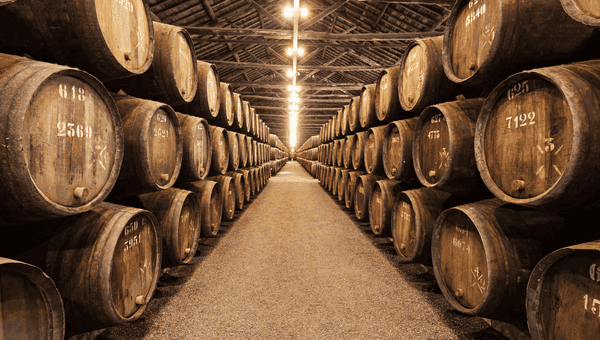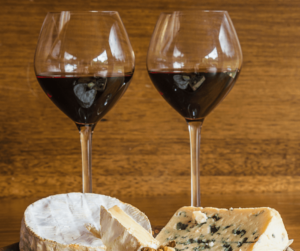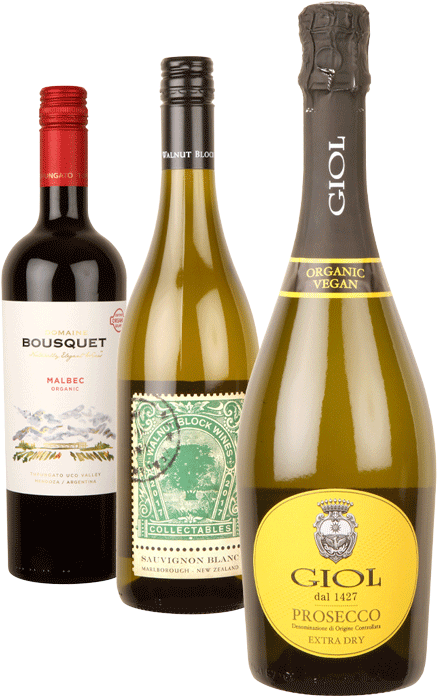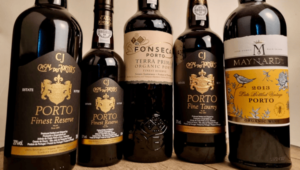How to Drink Port Wine? A Beginner’s Guide to Port

Port is one of the most famous fortified dessert wines on the planet. It’s higher in alcohol, and more viscous and heavier than traditional red wines, which makes it the perfect option for sipping and relaxing at the end of a meal. If you’ve ever wondered how to drink port, this guide is for you!
SIGN UP FOR £5 OFF YOUR FIRST ORDER HERE (with Port options too!)
In this blog post, we’ll walk you through Port wine, and we’ll teach you everything you need to know about this amazing fortified wine! Here’s what we’ll cover in this blog post, and you can click on these links below to jump to these topics if you’re after something specific:
- How to drink Port?
- What is Port Wine?
- What is the history of Port?
- Types of Port Wine
- What does Port taste like?
- Pairing Port with food
- Our recommended Ports
How to Drink Port Wine

If you want to know how to drink Port, you’ve come to the right place!
We recommend serving Tawny and Reserve Port at just below room temperature, around 10-16 C. This helps to bring out the sweetness and flavours of the dark red wine, without making the alcohol overpowering. Simply store it in a cooler room, or pop in the fridge for a bit.
For Rosé and White Port, you want to go a bit colder: 4-10 C (chill in the fridge for a couple of hours). These lighter Ports are better enjoyed more chilled. In Portugal, White Port is often enjoyed with tonic as an aperitif.
With Port, you don’t need to take a big mouthful at a time, rather approach it like a fine Brandy: with small sips. You want just enough that you get those delicious fruity and berry flavours.
Which glasses to use for Port?
Port is often served in smaller dessert of Port wine glasses, but you can also use a regular wine glass as well. Port glasses have a small, slender shape to help focus on the fruit, oak and spice flavours; you can find out more about different wine glasses here.
The standard serving size for Port is 75ml, meaning a full 750ml bottle could serve up to 10 people. It’s a stronger wine, so remember to take small sips.
If you’re looking for an organic Port to try out, we’d recommend Terra Prima’s Organic Reserve Port, one of our top selling most popular Port wines.
£25.00
We also recommend any of the Casal dos Jordoes Ports, they were the first fully certified organic Port makers and have won many awards for their Ports over the years. With strong flavours of figs, fruitcake, and prunes, their Finest Reserve Port is always recommended, also available in half bottle size.
£27.50
Do you need to decant Port?
Only Vintage Port and Crusted Port need to be decanted before serving, but you can decant any Port if you wish. Vintage and Crusted Ports need to be decanted because they have sediment in the bottle. This is not harmful to drink, just unpleasant. Any other Ports can be decanted if you want to release the aromas or add some theatre to the serving.
You don’t need to have a special decanter, any receptacle will do. Jugs, vases and milk bottles have all been used! You can rinse the original bottle with water and pour the Port back into the bottle to serve if desired.
How do you decant Port?
Simply stand the bottle upright for a day or two. This will move all the sediment to the bottom of the bottle. If you skip the step, remove the Port from your wine rack slowly and keep on its side. Open the bottle on an angle and pour slowly and steadily in one motion until you can see the sediment moving into the neck of the bottle. It may be useful to have a light source underneath the neck so you can see clearly. Traditionally, this is done with a candle, but a phone torchlight works just as well!
How long does Port last?
Many people ask us, “How long does Port last once opened?” and “Does Port go off quicker than other wines, due to its extra sugar content?”
Most wines will go off within a few days of opening, but Port can last for much longer, depending on the style. Vintage Ports are best consumed within a few days to a couple weeks (store in the fridge), but Reserve and Tawny Ports should last longer if stored in a cool dark place or the fridge.
You can also use a vacuum preserver to remove oxygen from the bottle before re-corking, which will make the wine last longer!
Ageing Port
The beauty of Port wine is that it can age much better than regular red wine. The best Vintage Ports can be aged for many decades in the bottle. Tawny and Reserve Ports will keep but can be drunk immediately, having been aged by the producer, which softens the tannins. The rich, dark aromas of the fruits and berries will give way to dried fruit and nut flavours.
What is Port Wine?
Let’s start off with the most important question, “What is Port wine?”
Port wine is a fortified red wine made in Portugal. In fact, it’s only made in the Douro Valley. It is often called a ‘dessert wine‘ due to its sweetness, but different styles can be drunk as aperitifs as well as after a meal.
People ask us, “What is Port made from? Surely it can’t be typical wine if it’s so strong!” That much is true. When you look into how is Port made, you’ll find it’s the same as wine, except it has Brandy added during fermentation. This gives it a higher alcohol content and more body. Brandy also stops the fermentation, ensuring the Port retains the grapes’ natural sweetness.
Port uses a unique blend of grapes native to Portugal. There are up to 52 grape varieties used to make Port, with the most common being:
- Touriga Franca
- Touriga Nacional
- Tinta Roriz (aka Tempranillo)
- Tinta Barroca
- Tinta Cão
The addition of many varieties of grapes lends a wide variety of flavours to the Port. Some grapes bring berry flavours, while others have chocolate, fig, or cinnamon flavours.
What is the history of Port?
The history of Port dates back to the 17th century when England was at war with France. With French wines banned, and later highly taxed, wine merchants looked elsewhere. The Anglo-Portuguese Treaty of 1373 had established ‘friendships, unions (and) alliances’, making Portugal an ideal choice for the English wine trade.
Moving inland up the Douro River, these vinous explorers struck gold, finding rich, deeply-coloured wines. Brandy was added to the wine to make sure the wine survived the journey back to England. At one of the wine-making monasteries in the area, monks were adding Brandy during fermentation, giving the sweet style of wine we know and love today.
In 1756 the production of Port became regulated and demarcated, becoming one of the first wine regions with a legal boundary. This area, with its beautiful meandering river and steep, terraced slopes, is now a Unesco World Heritage site
The British still have a strong presence in Port production. The many famous family brand names have now largely been consolidated. Symingtons, still family-owned, and currently run by Johnny Symington, own Warre, Dow, Cockburn and Graham. The Fladgate Partnership own Croft, Fonseca and Taylor.
Types of Port Wine
When you browse our list of organic Ports, you’ll see a few different types of Port: Reserve, Tawny and Vintage. Some producers even make white and pink versions now!
- Ruby Ports are the least expensive style, aged for one to three years in vat before bottling and sold ready to drink. Ruby Port does not improve if kept in the bottle.
- Tawny Ports get their name and colour from extended ageing in wooden casks before bottling, although this colour is sometimes achieved in other ways, like using lighter wines. If a Tawny Port has an indication of age, (ie 10, 20, 30 or 40 years) it will be of higher quality. Tawny Port is ready to drink once bottled and does not improve over time.
- Reserve Port is the next step up from both Ruby and non-age indicated Tawny, with a Port’s suitability for this category being determined by a tasting panel. A Reserve Tawny must be wood aged for a minimum of three years.
- Late Bottled Vintage (LBV) Ports are vintage wines that have been aged for between four and six years before they are bottled. The extra ageing helps to make these Ports more approachable, and they are ready to drink on release.
- Vintage Port is usually the most expensive Port. It is made in tiny quantities from the best grapes, and only in the very best years. It is aged for two years before being released but can improve for decades in the bottle.
- White Port is usually a lighter type of Port, made with white grapes. Common flavours include citrus peel, roasted nuts, baked apple, and apricot. There is less sweetness to this type of Port, depending on the producer, and it isn’t aged for as long.
- Rosé Port has much stronger berry flavours: strawberry, raspberry, and cranberry sauce. It can have delicious jammy notes that give it more sweetness than white Port, but it’s not as rich as a Tawny or Ruby Port.
What does Port taste like?
This will vary depending on the style, but all Port has a few common flavours. Generally, Port wine has strong berry flavours, including raspberries, blackberries, and prunes. Some of the other common Port flavours include chocolate, dried fruits, cinnamon and nuts. As Port ages, there’s an even wider array of flavours, including green peppercorn, hazelnut, figs, almond, butterscotch and more.
Pairing Port with Food: What to pair with Port?

Port is great with charcuterie and especially stronger cheeses, such as Stilton or other blue cheeses. Richer cheeses, like washed-rind cheese or blue cheese, bring out the sweetness of the Port wine and the berry flavours will enhance the cheese flavours without overpowering it. A small chunk of Stilton, a mince pie and a glass of Port is an unbeatable combination.
Another great way to pair Port with food is to serve it with smoked, salted, or roasted nuts. The nuttiness of Port, particularly Tawny Port, makes for a gorgeous combination of flavours. Any desserts made with chocolate and caramel will be a good option for pairing with Port. Port is also popular around Christmas time and pairs wonderfully well with Christmas puddings and other cakes with dried fruit in them.
Cooking with Port Wine
Cooking with wine, and especially cooking with Port, is a great way to add rich, fruity flavours to your meals. With Port, you want to use it for sauces in savoury and sweet dishes. You can make rich, gooey chocolate sauces to serve with cake.
If you want to make a delicious red wine reduction to serve with rich dishes such as venison or a nut roast, Port makes an excellent alternative. The higher sugar content of Port means it reduces into a thicker consistency than red wine. It’s a great way to bring depth and sweetness to meals. For cooking, Ruby or Reserve Port is your best choice.
More recommendations for Organic Port Wine
Port is one of our favourite wines, and it’s definitely not just for Christmas! We’re pleased to offer a wide selection of organic Port wines, here are more organic Ports we’d recommend trying:
Casal Jordoes Tawny Port: A delicious Tawny Port with soft, jammy flavours and a savoury note. Full-bodied, but a very approachable, it ages beautifully and makes for the perfect pairing with nuts.
£24.50
Maynards Port ‘Late Bottled Vintage’ 2013: is a very delicious, full flavoured Port that’s as good as a Vintage. Made from five organically grown Port grape varieties, this smooth, complex and serious wine is aged for over four years in the barrel.
Domaine Bousquet Fortified Malbec: Although not a Port, this Fortified Malbec is very similar in style to a Port Wine and it has won over many fans too. Described as ‘dense, rich, sweet and utterly heartwarming’, if you love Port you’ll surely love this too!
£15.75
We hope you’ve enjoyed this info all about how to drink Port! Port is truly one of the most unique of the wines and one you’d do well to add to your wine cellar. Check out our full range of organic Ports to see what takes your fancy. We’ve got something for every taste!















